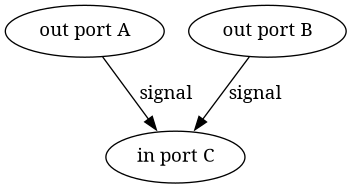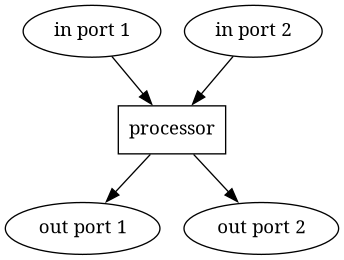Introduction
Thanks to Robin Gareus' advice and help, Zrythm uses a processing algorithm that depends on an acyclic graph of ports. This algorithm splits processing jobs into threads and processes each node until the terminal nodes are reached and there are no more "trigger nodes". The algorithm is explained in detail below.
The Graph
The processing Graph is an acyclic graph of GraphNode's. The graph is re-created every time there is a change in connections. When the graph gets (re)created, it goes through the project and finds all nodes that should be added to it and adds them, then creates NUM_CPU_CORES - 1 threads for processing trigger nodes (see below).
Nodes
GraphNode's can be either Processors or Ports.
Ports
Track's (Channel's) and Plugin's are made up of Port's. These ports can be connected with each other, as long as they are the same PortType (with a few exceptions) and of opposite PortFlow.
When these ports are connected, during processing, the signals from the source port are summed into the destination port. What this means in practice depends on the PortType. For audio, the signal is simply added to the existing one. For event/MIDI ports, the MidiEvent's from the source port are appended to the events of the destination port.

Processors
Processors are the other type of node in the graph and have input ports routing to them and output ports being routed from them. Unlike Port nodes, which simply sum their inputs, processors apply some processing to their inputs and update their outputs. Examples are TrackProcessor, Fader and Plugin.

Input ports routed to processors are processed in the same way as any other Port, in that they simply sum their inputs. When the processor does its processing, its input ports are already filled in and ready to use.
When the processor finishes processing, it writes the output into its output ports. A processor routes to output Port's in the graph.
- Note
- As a technical sidenote, processor input ports are indeed routed to the processor on the graph, however those input Port's have no outgoing connection to other Port's. Similarly, processor output ports are connected to the processor on the graph, however the Port's themselves have no incoming connection from other Port's (so they have no signals to sum when it is their turn to be processed - at that stage, they are already filled in by their processors).
Trigger and Terminal Nodes
Terminal nodes are nodes that don't route to any other node.
Trigger nodes are nodes that should be processed first. When they are processed, they are marked as processed and the reference count of the nodes they point to is decremented. When the reference count of a node becomes 0 (meaning it has no incoming connections), it becomes a trigger node. When the graph is constructed, it must have at least 1 trigger node.

When there are no more trigger nodes left, the processing cycle is completed.